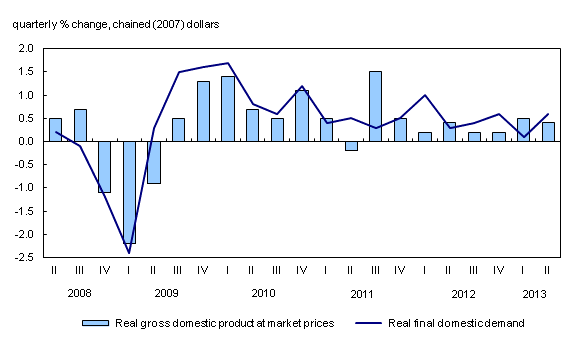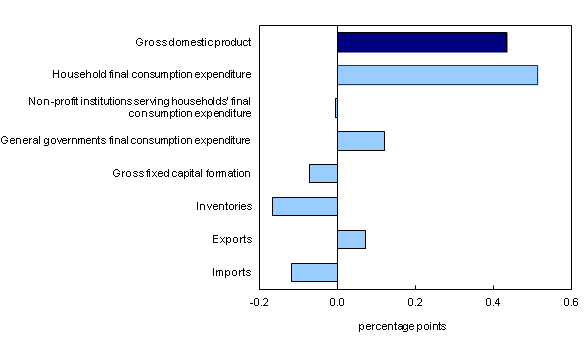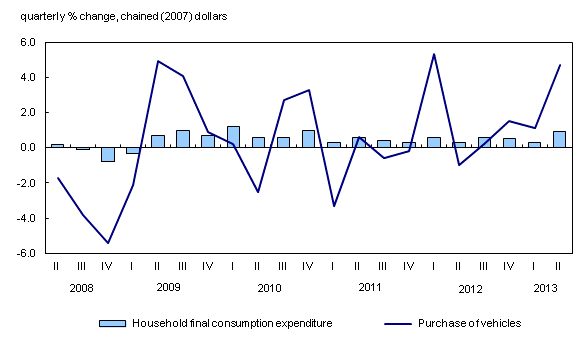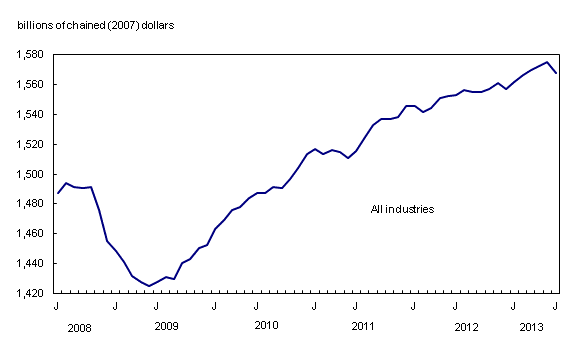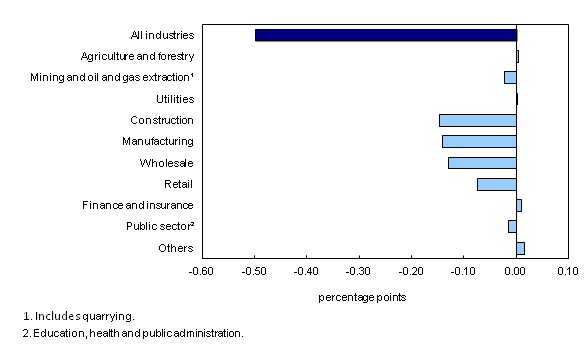Canadian economic accounts, second quarter 2013 and June 2013
Archived Content
Information identified as archived is provided for reference, research or recordkeeping purposes. It is not subject to the Government of Canada Web Standards and has not been altered or updated since it was archived. Please "contact us" to request a format other than those available.
Released: 2013-08-30
Real gross domestic product (GDP) expanded 0.4% in the second quarter, following 0.5% growth in the first quarter. On a monthly basis, real GDP by industry declined 0.5% in June.
Final domestic demand rose 0.6% in the second quarter. Household final consumption expenditure advanced 0.9%, led by higher spending on durable goods (+3.2%) and services (+0.7%).
Government final consumption expenditure rose 0.6%, the fourth consecutive quarterly gain.
Business gross fixed capital formation edged down 0.1% in the second quarter, despite a 1.3% increase in investment in residential structures.
Investment in non-residential structures and machinery and equipment was 0.6% lower, while outlays on intellectual property products declined 2.3%.
Exports edged up 0.2% in the second quarter, after advancing 1.3% in the first quarter. Imports were up 0.4%, following a 0.6% gain in the first quarter.
Inventory accumulation slowed in the second quarter as businesses added $5.2 billion worth of goods to inventories, down from the $7.7 billion added in the first quarter. The economy-wide stock-to-sales ratio was unchanged from the previous quarter.
The output of service industries expanded 0.7% in the second quarter, while goods-producing industries fell 0.5%.
Notable increases were recorded in retail and wholesale trade, the finance and insurance sector, professional services, as well as in the output of real estate agents and brokers.
Mining, quarrying, and oil and gas extraction decreased 1.7% in the second quarter, following two consecutive quarters of growth. Declines also occurred in manufacturing, the fourth quarterly decrease in a row, as well as in construction.
Expressed at an annualized rate, real GDP expanded 1.7% in the second quarter. By comparison, real GDP in the United States rose 2.5%.
Consumer spending boosted by vehicle purchases
Household final consumption expenditure advanced 0.9% in the second quarter, the strongest pace since the fourth quarter of 2010. Spending on goods was up 1.2%, led by durable goods (+3.2%). Spending on services was 0.7% higher.
Transport purchases, which contributed over one-third of the growth in household spending, were boosted by a 4.7% increase in purchases of vehicles in the second quarter. This was the fourth consecutive quarterly increase in vehicle purchases, and the strongest advance since the first quarter of 2012.
Spending on insurance and financial services increased 1.4%, reflecting in part higher claims as a result of extensive flooding in Southern Alberta in the second half of June.
Food, beverage and accommodation services (+1.0%) and recreation and culture (+0.8%) also contributed to the growth in household spending.
Expenditures were notably lower on clothing and footwear (-0.9%) and alcoholic beverages and tobacco (-0.5%).
Housing up after three quarters of contraction
Business gross fixed capital formation in residential structures increased 1.3% in the second quarter, following three consecutive quarterly declines. The increase stemmed from higher resale activity, as ownership transfer costs went up 5.9%, and renovations increased 1.6%. The value of new home construction (-0.6%) declined for a second consecutive quarter.
Business outlays on plant and equipment turn down
Business gross fixed capital formation in non-residential structures and machinery and equipment fell 0.6% in the second quarter, following two consecutive quarterly increases. Investment in non-residential structures declined 0.7%. The decrease was driven by lower investment in non-residential buildings (-2.6%), due in part to the construction strike in Quebec during the last two weeks of June.
Business investment in machinery and equipment was down 0.5% in the second quarter, following a flat first quarter. Industrial machinery and equipment (-1.2%) and computers and computer peripheral equipment (-2.3%) were the main contributors to the decline. Outlays on communications and audio and video equipment (+5.7%) were notably higher.
Business inventory accumulation weaker than in the first quarter
Non-farm business inventories increased $3.4 billion in the second quarter, down from the $9.0 billion added in the first quarter.
There was a significant buildup of inventory at the wholesale level, as wholesalers added to their stocks of durable and non-durable goods during the quarter. Retailers ran down their inventories of motor vehicles and other durable goods. Manufacturers also depleted their inventories.
Farm inventories increased $1.4 billion, reflecting good growing conditions for grains and other crops in the first half of the year. This increase followed declines in the previous six quarters.
Government spending continues to expand
Government real final consumption expenditure rose 0.6% in the second quarter, the fourth consecutive quarterly gain. Federal and local government spending were the main contributors to the increase in the second quarter.
Federal spending advanced 1.9%, the first increase since the fourth quarter of 2011. Local government spending (+1.0%) continued up.
Expenditures by provincial and territorial governments were flat, following three quarterly increases.
Exports edge up following a strong first quarter
Exports of goods and services edged up by 0.2% in the second quarter, following a 1.3% gain in the first quarter.
Exports of goods advanced 0.4%, after growing 1.2% in the first quarter. Metal and non-metallic mineral products (+4.8%), basic and industrial chemical, plastic and rubber products (+6.4%), and motor vehicles and parts (+3.2%) were among the major contributors to the increase.
Exports of energy products (-6.3%) and farm, fishing and intermediate food products (-6.5%) were notably lower.
Service exports decreased 0.8%, following a 1.7% gain in the first quarter. The decrease was driven by lower exports of commercial services (-1.8%).
Imports advance at a slower pace than in the first quarter
Imports of goods and services grew 0.4% in the second quarter, after increasing 0.6% in the first quarter. Imports have increased in all but one quarter since the second quarter of 2009. The exception was the fourth quarter of 2012 (-0.8%).
Imports of goods advanced 0.8%. Electronic and electrical equipment and parts (+7.9%), motor vehicles and parts (+3.0%) and metal and non-metallic mineral products (+1.6%) were among the main sources of strength.
Imports of metal ores and non-metallic minerals (-20.6%) and forestry products and building and packaging materials (-4.2%) were among the main sources of weakness.
Imports of services decreased 1.6%, the third consecutive quarterly decline. Imports of commercial services (-4.0%) also fell for a third consecutive quarter.
Economy-wide income grows at slowest pace in four quarters
Nominal GDP grew 0.4% in the second quarter. This followed a 1.0% increase in the first quarter, and gains of 0.7% in the two previous quarters.
Compensation of employees rose 0.9%, following a 0.8% gain in the first quarter. Wages and salaries were up by 1.4% in goods-producing industries and by 0.8% in service-producing industries in the second quarter.
The net operating surplus of corporations fell 4.4% in the second quarter. That of non-financial corporations fell 5.1%, after gaining 0.7% in the first quarter. This was the fifth contraction in six quarters in this sector. However, financial corporations' net operating surplus increased 2.7% in the second quarter.
Household saving rate lower
Household final consumption expenditure (in current dollars) increased (+1.0%) at a faster pace than household disposable income (+0.8%) in the second quarter. The household saving rate was 5.1%, down from 5.3% in the first quarter.
The household debt service ratio, defined as household mortgage and non-mortgage interest paid divided by disposable income, was 7.15% in the second quarter, down from 7.26% in the first quarter and from the average rate of 7.3% recorded in 2012.
The national saving rate was 4.0% in the second quarter, down from 5.0% in the first quarter. The decrease stemmed mainly from the sharply lower savings of non-financial corporations.
Weaker terms of trade restrain gains in real domestic income
A weakening in Canada's terms of trade, resulting from lower prices for exports relative to imports, restrained the growth in real gross domestic income to 0.2% in the second quarter.
Export prices declined by 0.2% while import prices were 0.6% higher. The overall price of goods and services produced in Canada edged down 0.1%.
The price of final domestic demand rose 0.2%, after growing 0.5% in the first quarter.
Gross domestic product by industry, June 2013
Following five consecutive monthly increases, real gross domestic product fell 0.5% in June, as many major industrial sectors recorded lower production. Notable declines were recorded in construction, wholesale and retail trade, and manufacturing. Mining, quarrying, and oil and gas extraction, the arts and entertainment sector as well as transportation and accommodation services also decreased in June. However, the output of real estate agents and brokers and insurance carriers increased.
Construction declined 1.9% in June, partly because of a labour dispute in Quebec. Non-residential building construction fell 7.3%. Residential building construction, as well as repair and engineering construction, also declined.
After posting strong increases in May, both wholesale and retail trade were down in June. Wholesale trade fell 2.4% as decreases were widespread. Notable declines were registered by miscellaneous wholesalers, which includes agricultural supplies, and in building materials and supplies. Retail trade was down 1.4% in June, following three consecutive monthly increases. Food and beverage stores, as well as motor vehicle and parts dealers contributed the most to the decline in June after having both increased in May.
Manufacturing production declined 1.3% in June, as durable goods fell 2.6% while non-durable goods increased 0.3%. Declines were recorded in 15 out of 19 major manufacturing sub-sectors, with notable decreases in machinery, fabricated metal products, and beverage and tobacco products. In contrast, output at refineries increased significantly in June, following the end of maintenance work at some facilities in April and May.
Mining, quarrying, and oil and gas extraction declined 0.3%. The increase in oil and gas production was outweighed by decreases in potash and coal mining as well as support activities for mining and oil and gas extraction.
The arts and entertainment sector declined 4.3%, as attendance at sporting events was down in June.
The output of real estate agents and brokers was up for the fourth consecutive month, as activity in the home resale market increased in almost all major urban markets.
Services provided by insurance carriers increased in June, in part due to flooding in Alberta.
Products, services and contact information
Detailed analysis and tables
The National economic accounts module, accessible from the Browse by key resource module of our website, features an up-to-date portrait of national and provincial economies and their structure.
Links to other releases from the national accounts can be found in the second quarter 2013 issue of Canadian Economic Accounts Quarterly Review, Vol. 12, no. 2 (Catalogue number13-010-X). This publication is now available from the Browse by key resource module of our website under Publications. This publication will be updated on September 13, at the time of the release of the financial flow and national balance sheet accounts.
Note to readers
For more information on seasonal adjustment, see Seasonal adjustment and identifying economic trends.
Percentage changes for expenditure-based and industry-based statistics (such as personal expenditures, investment, exports, imports and output) are calculated from volume measures that are adjusted for price variations. Percentage changes for income-based and flow-of-funds statistics (such as labour income, corporate profits, mortgage borrowing and total funds raised) are calculated from nominal values; that is, they are not adjusted for price variations.
There are four ways of expressing growth rates for gross domestic product (GDP) and other time series found in this release.
1. Unless otherwise stated, the growth rates of all quarterly data in this release represent the percentage change in the series from one quarter to the next, such as from the first quarter of 2013 to the second quarter of 2013.
2. Quarterly growth can be expressed at an annual rate by using a compound growth formula, similar to the way in which a monthly interest rate can be expressed at an annual rate. Expressing growth at an annual rate facilitates comparisons with official GDP statistics from the United States. Both the quarterly growth rate and the annualized quarterly growth rate should be interpreted as an indication of the latest trend in GDP.
3. The year-over-year growth rate is the percentage change in GDP from a given quarter in one year to the same quarter one year later, such as from the second quarter of 2012 to the second quarter of 2013.
4. The growth rates of all monthly data in this article represent the percentage change in the series from one month to the next, such as from May to June 2013.
Data on gross domestic product by industry for July will be released on September 30.
Products
Data on gross domestic product for the second quarter have been released along with revised data for the first quarter. Revised data on current transfers between non-residents and the corporate sector for the period 1981 to 2012 have also been released, to align with the Balance of Payments program.
Data on gross domestic product by income and by expenditure for the third quarter will be released on November 29. For more information, consult the Guide to the Income and Expenditure Accounts (Catalogue number13-017-X).
To enquire about the concepts, methods or data quality of this release, contact us (toll-free 1-800-263-1136; infostats@statcan.gc.ca) or Media Relations (613-951-4636; statcan.mediahotline-ligneinfomedias.statcan@canada.ca).
Contact information
For more information, or to order data, contact us (toll-free 1-800-263-1136; infostats@statcan.gc.ca).
To enquire about the concepts, methods or data quality of this release, contact Allan Tomas (613-951-9277), Industry Accounts Division.
- Date modified:


